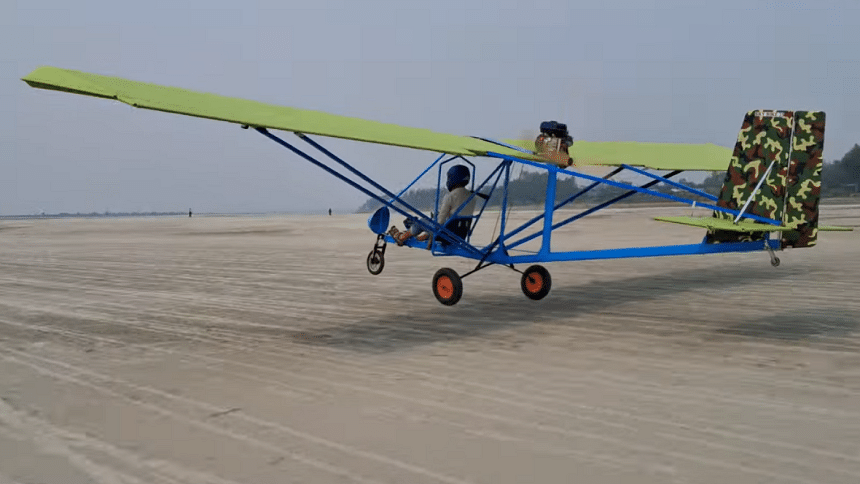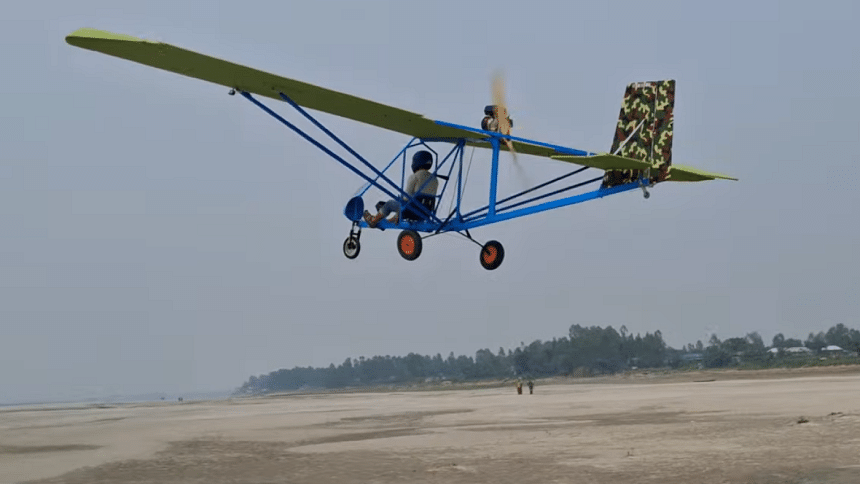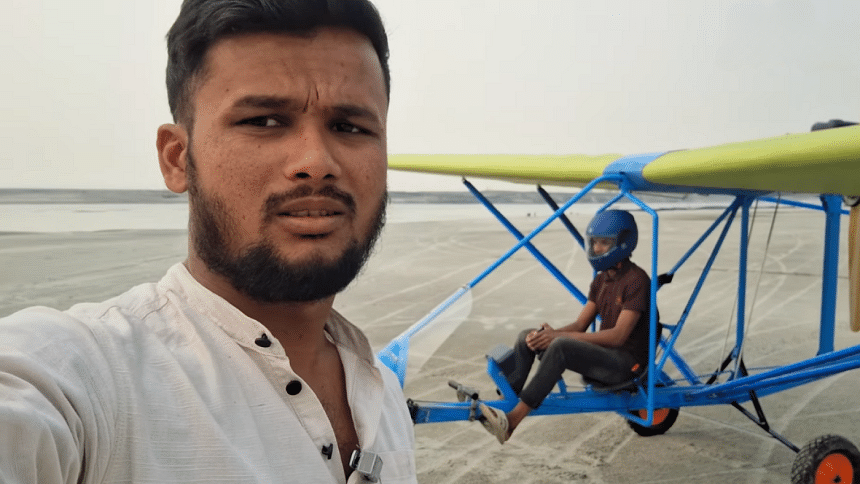The man who flew

On March 4, 2025, the sky over Jafarganj, near the banks of the Jamuna River, witnessed a remarkable feat—one that defied the expectations of an entire village. Amidst the cheers of an awestruck crowd, Julhas Molla, a 28-year-old electronic mechanic from Shaitgar Teota village in Shibalaya upazila, successfully flew an ultralight aircraft that he built with his own hands.
This was no ordinary flight. The aircraft, weighing over 100 kilograms, was entirely handcrafted by Julhas, using a mix of aluminium, stainless steel, and iron. Fitted with a digital speedometer and powered by a modest 7-horsepower water pump engine, the aircraft climbed to an altitude of 50 feet before Julhas brought it safely back to the ground. It was a moment of triumph—not just for him, but for everyone who had doubted that such an achievement was possible in a small Bangladeshi village.
From dream to reality
Julhas's journey to the sky was not an easy one. He had no formal engineering degree, nor did he have access to sophisticated aeronautical resources. What he did have, however, was an unshakable determination and a deep-rooted passion for aviation.
His fascination with flight began four years ago when he started experimenting with radio-controlled (RC) aircraft. Inspired by YouTube videos of aviation enthusiasts, he began designing and assembling small RC planes. But Julhas wasn't satisfied with remote-controlled models—he wanted to build something he could fly himself.
"In 2021, I attempted to make an RC aircraft. The process was challenging, but I kept learning from my failures. By 2023, I gained the confidence that I could build a full-sized ultralight aircraft," Julhas told The Daily Star.
His first attempt at a manned aircraft in 2024 was a modest success—it lifted 10 to 12 feet off the ground. But he quickly realized that his design was not safe enough. Rather than giving up, he dismantled it and started anew, fine-tuning his design for an entire year before his final, successful flight in 2025.


The mechanism of innovation
Julhas's aircraft is a testament to his ingenuity. Built on a tight budget, it features a gasoline engine that can run on petrol or octane, consuming about one litre for every 25 to 30 kilometres of flight. The wings, covered in fabric, span an impressive 32 feet, while the body measures 18 feet long.
The aircraft takes off at a speed of 45 kilometres per hour and can reach a top speed of 70 kilometres per hour in the air. Though it was designed primarily for experimental training rather than commercial use, Julhas is confident that with proper funding and sponsorship, mass production of similar aircraft could be possible.
"I didn't try to fly it higher than 50 feet because this was just an experimental flight. But if I get the support, I believe I can improve the design and make it even more functional," he said in a conversation with The Daily Star.
A story of resilience
Julhas's success is all the more inspiring given the hardships he has faced. Originally from Baghutia in Daulatpur upazila, his family was forced to relocate due to severe river erosion. Financial difficulties meant that despite securing a respectable GPA of 4.25 in his Secondary School Certificate (SSC) examination in 2014, he was unable to continue his education as he had hoped.
"I wanted to pursue a diploma in electrical engineering, but due to our financial situation, I had to settle for admission to a local college. Even then, I had to drop out after just six months," he recalled when asked about his educational background.
Undeterred, he moved to Dhaka and began working as an electronic mechanic. Though life in the city was not easy, Julhas shared that this job allowed him to support his family while quietly nurturing his passion for aviation.

A community effort
Julhas's success has been a collective victory for his family and friends, who stood by him despite the scepticism of others. He is the fifth among six brothers and two sisters, and while his family was initially unsure about his ambitious project, their unwavering support kept him motivated.
"I wouldn't have been able to do this without the encouragement of my friends and family," he said.
Beyond his personal circle, Julhas has also built a growing online community through his YouTube channel, RC Life, where he shares videos of his experiments and aviation-related innovations. His channel has not only helped him document his journey but has also connected him with like-minded enthusiasts from around the world.
From a global aviation perspective, a maiden flight like this is more than a century late—Wilbur and Orville Wright made history in 1903. But that is not the point.
Looking ahead
What sets Julhas's achievement apart is not the altitude or distance covered, but the journey that led him to this moment. With no formal engineering education, no state-of-the-art laboratory, and only sheer determination, he built his own plane, flew it and proved that dreams, no matter how ambitious, can take flight.
As for Julhas, the sky is no longer the limit—it is just the beginning. His ultimate dream is to make aviation technology more accessible in Bangladesh. With the right funding, he envisions a future where affordable, locally manufactured ultralight aircraft become a reality.

 For all latest news, follow The Daily Star's Google News channel.
For all latest news, follow The Daily Star's Google News channel. 



Comments